Problem Solving Approaches and Models in Leadership Management
VerifiedAdded on 2023/06/13
|16
|3321
|53
Report
AI Summary
This report delves into various problem-solving methodologies applicable to leadership management, addressing challenges faced by multinational companies, such as data theft and financial risks. It contrasts resolution, solving, and dissolving techniques, emphasizing the importance of thinking skills in decision-making. The report applies heuristic and systematic approaches to solve everyday problems and analyzes the 'Undercover Boss' TV series to identify business challenges and opportunities. It further evaluates the significance of aligning problem-solving with business goals, using the Stena Line case study. The document also compares the ideal and creative problem-solving models and suggests using the PDCA and IDEAL models to address specific issues faced by The Business School of Auckland. Desklib provides access to this and other solved assignments.

Running head: PROBLEM SOLVING
Problem Solving
Name of the Student:
Name of the University:
Author Note:
Problem Solving
Name of the Student:
Name of the University:
Author Note:
Paraphrase This Document
Need a fresh take? Get an instant paraphrase of this document with our AI Paraphraser
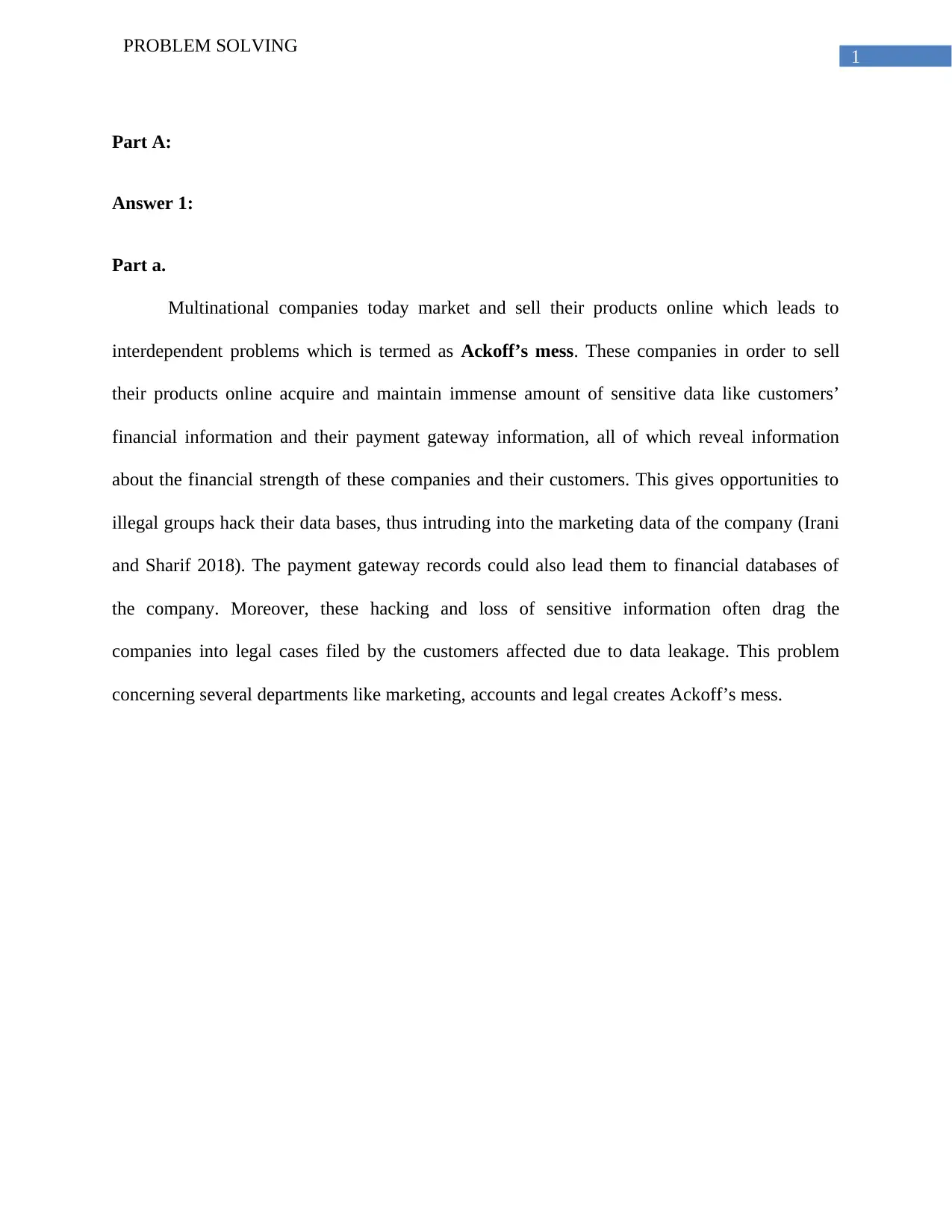
1
PROBLEM SOLVING
Part A:
Answer 1:
Part a.
Multinational companies today market and sell their products online which leads to
interdependent problems which is termed as Ackoff’s mess. These companies in order to sell
their products online acquire and maintain immense amount of sensitive data like customers’
financial information and their payment gateway information, all of which reveal information
about the financial strength of these companies and their customers. This gives opportunities to
illegal groups hack their data bases, thus intruding into the marketing data of the company (Irani
and Sharif 2018). The payment gateway records could also lead them to financial databases of
the company. Moreover, these hacking and loss of sensitive information often drag the
companies into legal cases filed by the customers affected due to data leakage. This problem
concerning several departments like marketing, accounts and legal creates Ackoff’s mess.
PROBLEM SOLVING
Part A:
Answer 1:
Part a.
Multinational companies today market and sell their products online which leads to
interdependent problems which is termed as Ackoff’s mess. These companies in order to sell
their products online acquire and maintain immense amount of sensitive data like customers’
financial information and their payment gateway information, all of which reveal information
about the financial strength of these companies and their customers. This gives opportunities to
illegal groups hack their data bases, thus intruding into the marketing data of the company (Irani
and Sharif 2018). The payment gateway records could also lead them to financial databases of
the company. Moreover, these hacking and loss of sensitive information often drag the
companies into legal cases filed by the customers affected due to data leakage. This problem
concerning several departments like marketing, accounts and legal creates Ackoff’s mess.

2
PROBLEM SOLVING
Data theft
Loss of customer trusts
Loss of sensitive financial data of the
company
Loss of
marketing
data and
hampers
future
business
Legal cases
filed by
affected
customers
Business
loss
Financial loss, loss of goodwill
Figure 1. Figure showing Ackoff's mess due to data theft
(Source: Author)
PROBLEM SOLVING
Data theft
Loss of customer trusts
Loss of sensitive financial data of the
company
Loss of
marketing
data and
hampers
future
business
Legal cases
filed by
affected
customers
Business
loss
Financial loss, loss of goodwill
Figure 1. Figure showing Ackoff's mess due to data theft
(Source: Author)
⊘ This is a preview!⊘
Do you want full access?
Subscribe today to unlock all pages.

Trusted by 1+ million students worldwide
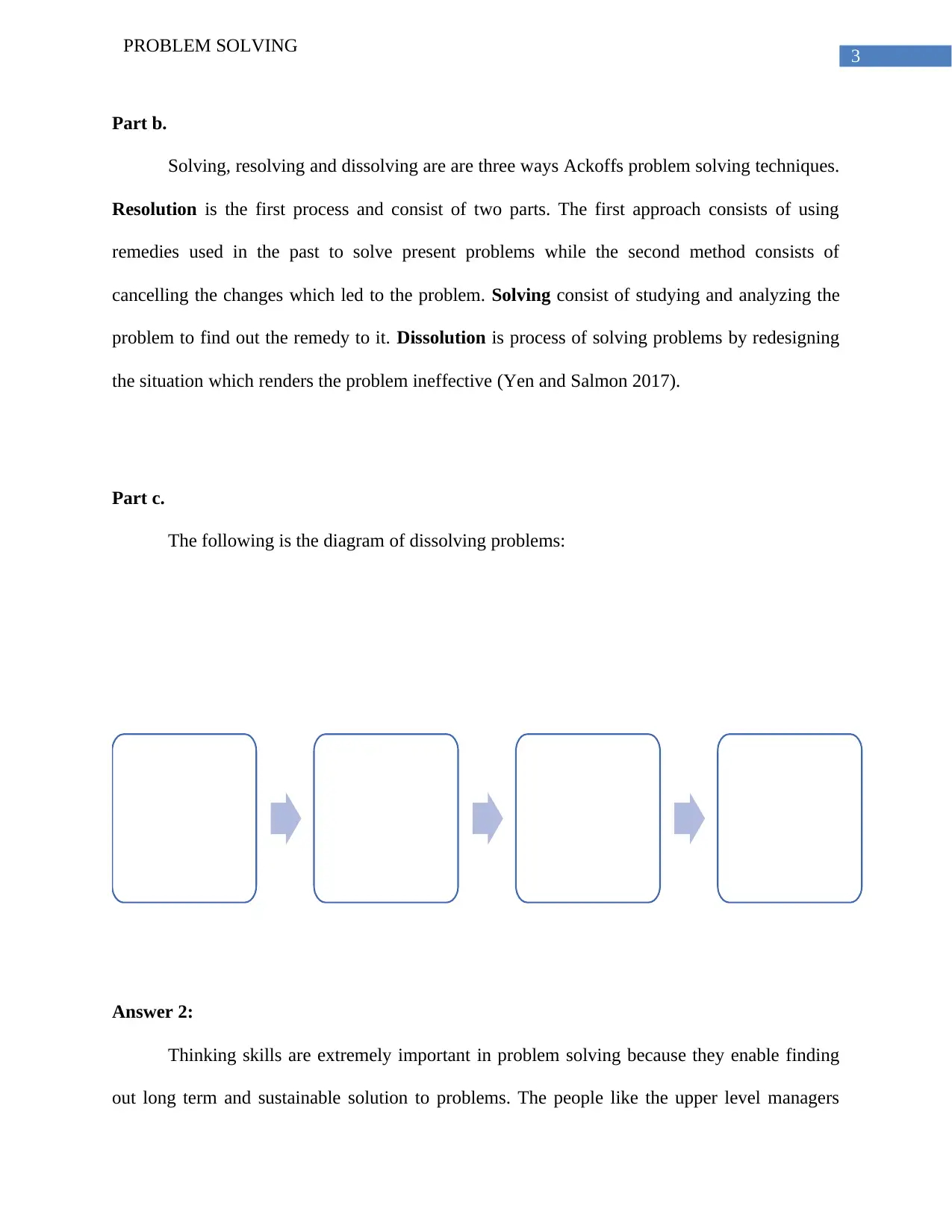
3
PROBLEM SOLVING
Part b.
Solving, resolving and dissolving are are three ways Ackoffs problem solving techniques.
Resolution is the first process and consist of two parts. The first approach consists of using
remedies used in the past to solve present problems while the second method consists of
cancelling the changes which led to the problem. Solving consist of studying and analyzing the
problem to find out the remedy to it. Dissolution is process of solving problems by redesigning
the situation which renders the problem ineffective (Yen and Salmon 2017).
Part c.
The following is the diagram of dissolving problems:
Answer 2:
Thinking skills are extremely important in problem solving because they enable finding
out long term and sustainable solution to problems. The people like the upper level managers
Identifying the
causes of the
problem
Identifying the
factors or
arrangement of
factors causing
the problem
Changing the
setting of the
factors to
mitigate the
problem
Finding long
term solution
PROBLEM SOLVING
Part b.
Solving, resolving and dissolving are are three ways Ackoffs problem solving techniques.
Resolution is the first process and consist of two parts. The first approach consists of using
remedies used in the past to solve present problems while the second method consists of
cancelling the changes which led to the problem. Solving consist of studying and analyzing the
problem to find out the remedy to it. Dissolution is process of solving problems by redesigning
the situation which renders the problem ineffective (Yen and Salmon 2017).
Part c.
The following is the diagram of dissolving problems:
Answer 2:
Thinking skills are extremely important in problem solving because they enable finding
out long term and sustainable solution to problems. The people like the upper level managers
Identifying the
causes of the
problem
Identifying the
factors or
arrangement of
factors causing
the problem
Changing the
setting of the
factors to
mitigate the
problem
Finding long
term solution
Paraphrase This Document
Need a fresh take? Get an instant paraphrase of this document with our AI Paraphraser

4
PROBLEM SOLVING
involved in the finding remedies to challenges facing organizations involve processes like
brainstorming and debating point out possible alternatives to counteract the challenge. They then
find the best strategy to meet the challenge (Houghton and Tuffley 2015). Thus, thinking and
decision-making skills are important for finding appropriate solutions to challenges organizations
counter.
Answer 3:
The solution to the stated problem of not finding the house keys can be solved using two
problem solving methods, the heuristic approach and systematic approach. As per the heuristic
approach, the possible solution to the problem would be leaving the house through the back door,
assuming that the back door can also be used to approach the front gate (Mateo, Navamuel &
Villa 2017).
The solution as per the systematic approach would consist of analysing the problem of
not finding the keys to consider various long term solutions. The solutions could using an
alternative lock, if possible, calling up the lock and key experts or finding out the alternative
keys. The second solution of calling up a lock and key expert seems to the best alternative
solution (Elsawah and Guillaume 2016).
Section II:
Answer 1:
The TV series named ‘Undercover Boss’ presents two challenges before the character
Gunnar Blomdahl, the CEO of Stena Line, a leading international ferry making company. the
two challenges are, that he is a Norwegian origin and the second challenge is that the company
Stena Line was investing in a project of building two new expensive ferries and two new ships,
PROBLEM SOLVING
involved in the finding remedies to challenges facing organizations involve processes like
brainstorming and debating point out possible alternatives to counteract the challenge. They then
find the best strategy to meet the challenge (Houghton and Tuffley 2015). Thus, thinking and
decision-making skills are important for finding appropriate solutions to challenges organizations
counter.
Answer 3:
The solution to the stated problem of not finding the house keys can be solved using two
problem solving methods, the heuristic approach and systematic approach. As per the heuristic
approach, the possible solution to the problem would be leaving the house through the back door,
assuming that the back door can also be used to approach the front gate (Mateo, Navamuel &
Villa 2017).
The solution as per the systematic approach would consist of analysing the problem of
not finding the keys to consider various long term solutions. The solutions could using an
alternative lock, if possible, calling up the lock and key experts or finding out the alternative
keys. The second solution of calling up a lock and key expert seems to the best alternative
solution (Elsawah and Guillaume 2016).
Section II:
Answer 1:
The TV series named ‘Undercover Boss’ presents two challenges before the character
Gunnar Blomdahl, the CEO of Stena Line, a leading international ferry making company. the
two challenges are, that he is a Norwegian origin and the second challenge is that the company
Stena Line was investing in a project of building two new expensive ferries and two new ships,
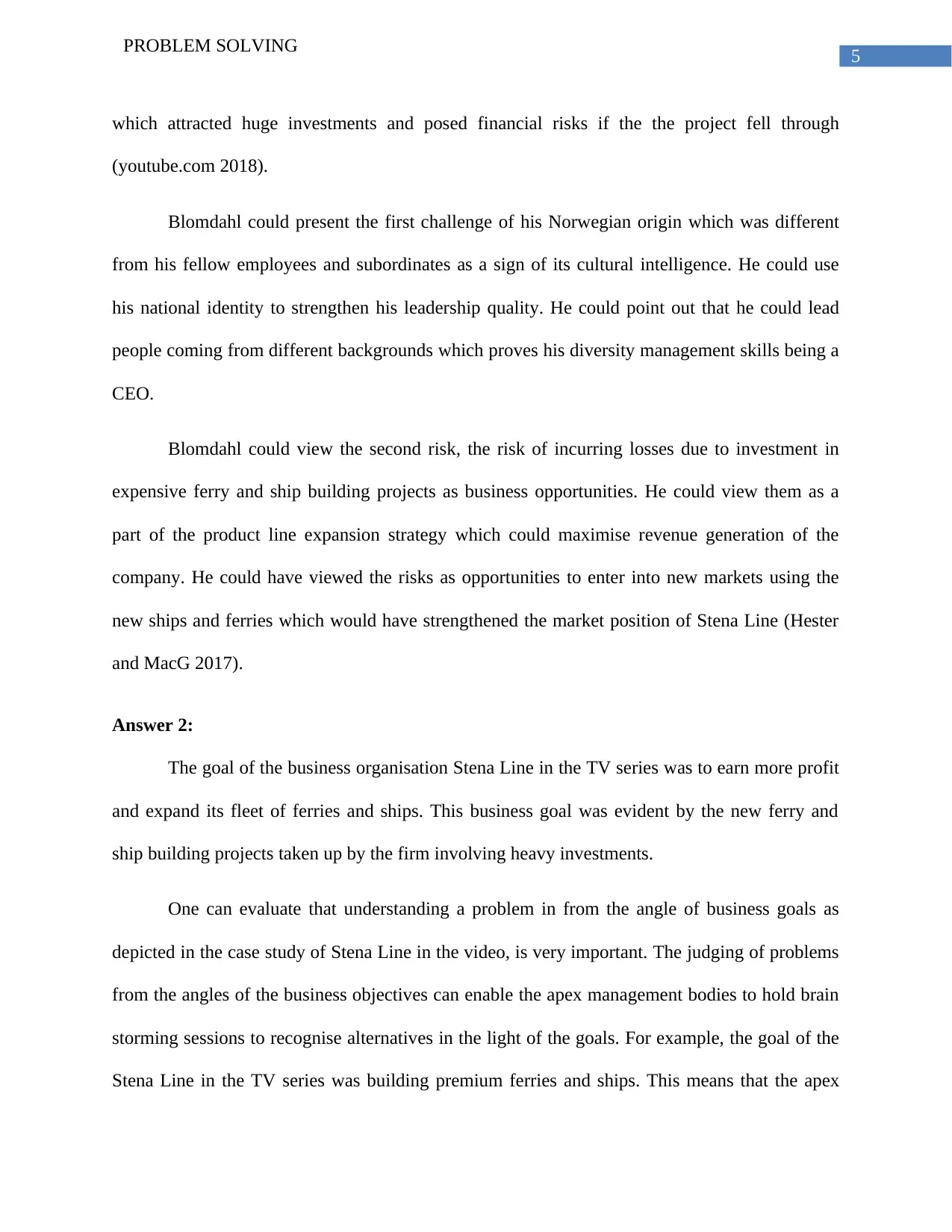
5
PROBLEM SOLVING
which attracted huge investments and posed financial risks if the the project fell through
(youtube.com 2018).
Blomdahl could present the first challenge of his Norwegian origin which was different
from his fellow employees and subordinates as a sign of its cultural intelligence. He could use
his national identity to strengthen his leadership quality. He could point out that he could lead
people coming from different backgrounds which proves his diversity management skills being a
CEO.
Blomdahl could view the second risk, the risk of incurring losses due to investment in
expensive ferry and ship building projects as business opportunities. He could view them as a
part of the product line expansion strategy which could maximise revenue generation of the
company. He could have viewed the risks as opportunities to enter into new markets using the
new ships and ferries which would have strengthened the market position of Stena Line (Hester
and MacG 2017).
Answer 2:
The goal of the business organisation Stena Line in the TV series was to earn more profit
and expand its fleet of ferries and ships. This business goal was evident by the new ferry and
ship building projects taken up by the firm involving heavy investments.
One can evaluate that understanding a problem in from the angle of business goals as
depicted in the case study of Stena Line in the video, is very important. The judging of problems
from the angles of the business objectives can enable the apex management bodies to hold brain
storming sessions to recognise alternatives in the light of the goals. For example, the goal of the
Stena Line in the TV series was building premium ferries and ships. This means that the apex
PROBLEM SOLVING
which attracted huge investments and posed financial risks if the the project fell through
(youtube.com 2018).
Blomdahl could present the first challenge of his Norwegian origin which was different
from his fellow employees and subordinates as a sign of its cultural intelligence. He could use
his national identity to strengthen his leadership quality. He could point out that he could lead
people coming from different backgrounds which proves his diversity management skills being a
CEO.
Blomdahl could view the second risk, the risk of incurring losses due to investment in
expensive ferry and ship building projects as business opportunities. He could view them as a
part of the product line expansion strategy which could maximise revenue generation of the
company. He could have viewed the risks as opportunities to enter into new markets using the
new ships and ferries which would have strengthened the market position of Stena Line (Hester
and MacG 2017).
Answer 2:
The goal of the business organisation Stena Line in the TV series was to earn more profit
and expand its fleet of ferries and ships. This business goal was evident by the new ferry and
ship building projects taken up by the firm involving heavy investments.
One can evaluate that understanding a problem in from the angle of business goals as
depicted in the case study of Stena Line in the video, is very important. The judging of problems
from the angles of the business objectives can enable the apex management bodies to hold brain
storming sessions to recognise alternatives in the light of the goals. For example, the goal of the
Stena Line in the TV series was building premium ferries and ships. This means that the apex
⊘ This is a preview!⊘
Do you want full access?
Subscribe today to unlock all pages.

Trusted by 1+ million students worldwide
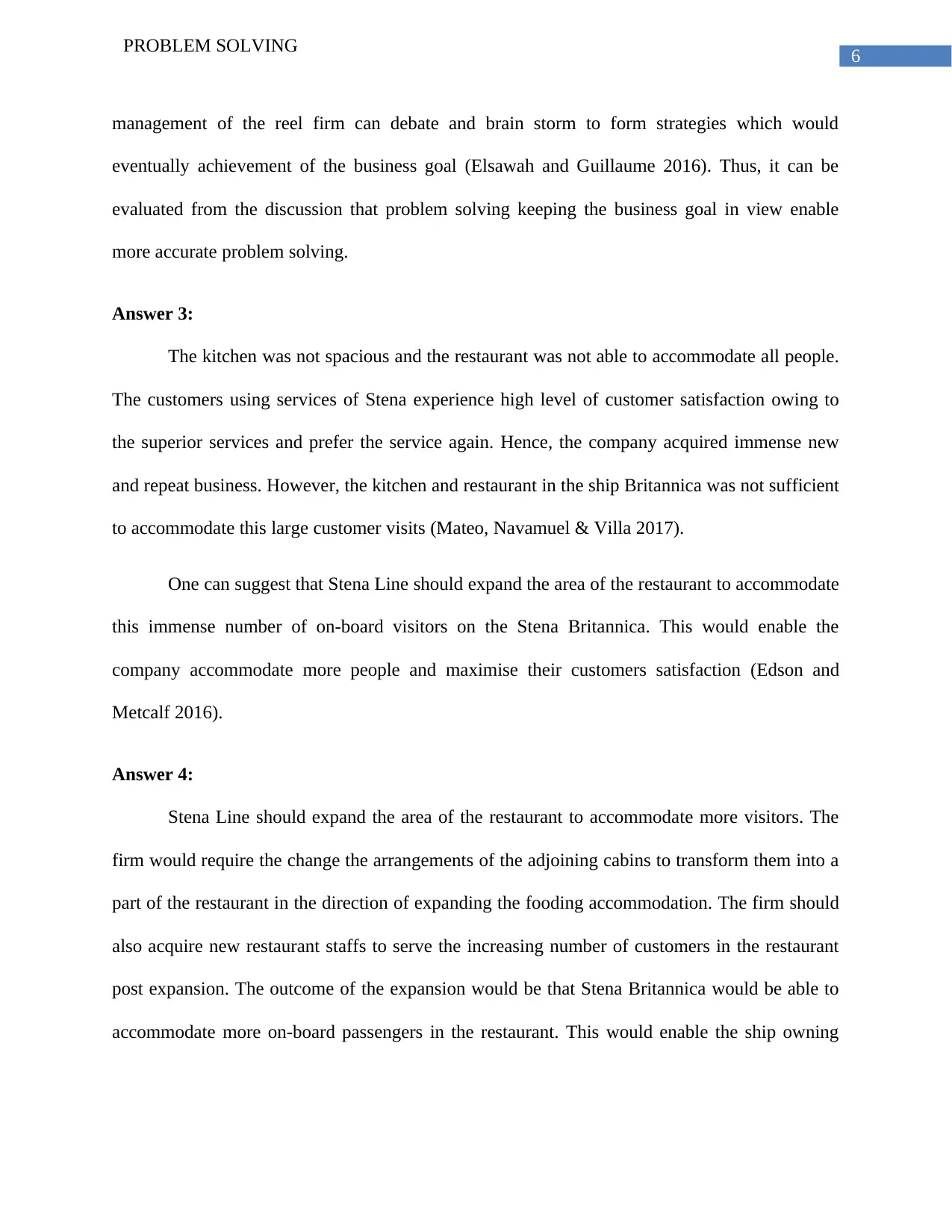
6
PROBLEM SOLVING
management of the reel firm can debate and brain storm to form strategies which would
eventually achievement of the business goal (Elsawah and Guillaume 2016). Thus, it can be
evaluated from the discussion that problem solving keeping the business goal in view enable
more accurate problem solving.
Answer 3:
The kitchen was not spacious and the restaurant was not able to accommodate all people.
The customers using services of Stena experience high level of customer satisfaction owing to
the superior services and prefer the service again. Hence, the company acquired immense new
and repeat business. However, the kitchen and restaurant in the ship Britannica was not sufficient
to accommodate this large customer visits (Mateo, Navamuel & Villa 2017).
One can suggest that Stena Line should expand the area of the restaurant to accommodate
this immense number of on-board visitors on the Stena Britannica. This would enable the
company accommodate more people and maximise their customers satisfaction (Edson and
Metcalf 2016).
Answer 4:
Stena Line should expand the area of the restaurant to accommodate more visitors. The
firm would require the change the arrangements of the adjoining cabins to transform them into a
part of the restaurant in the direction of expanding the fooding accommodation. The firm should
also acquire new restaurant staffs to serve the increasing number of customers in the restaurant
post expansion. The outcome of the expansion would be that Stena Britannica would be able to
accommodate more on-board passengers in the restaurant. This would enable the ship owning
PROBLEM SOLVING
management of the reel firm can debate and brain storm to form strategies which would
eventually achievement of the business goal (Elsawah and Guillaume 2016). Thus, it can be
evaluated from the discussion that problem solving keeping the business goal in view enable
more accurate problem solving.
Answer 3:
The kitchen was not spacious and the restaurant was not able to accommodate all people.
The customers using services of Stena experience high level of customer satisfaction owing to
the superior services and prefer the service again. Hence, the company acquired immense new
and repeat business. However, the kitchen and restaurant in the ship Britannica was not sufficient
to accommodate this large customer visits (Mateo, Navamuel & Villa 2017).
One can suggest that Stena Line should expand the area of the restaurant to accommodate
this immense number of on-board visitors on the Stena Britannica. This would enable the
company accommodate more people and maximise their customers satisfaction (Edson and
Metcalf 2016).
Answer 4:
Stena Line should expand the area of the restaurant to accommodate more visitors. The
firm would require the change the arrangements of the adjoining cabins to transform them into a
part of the restaurant in the direction of expanding the fooding accommodation. The firm should
also acquire new restaurant staffs to serve the increasing number of customers in the restaurant
post expansion. The outcome of the expansion would be that Stena Britannica would be able to
accommodate more on-board passengers in the restaurant. This would enable the ship owning
Paraphrase This Document
Need a fresh take? Get an instant paraphrase of this document with our AI Paraphraser
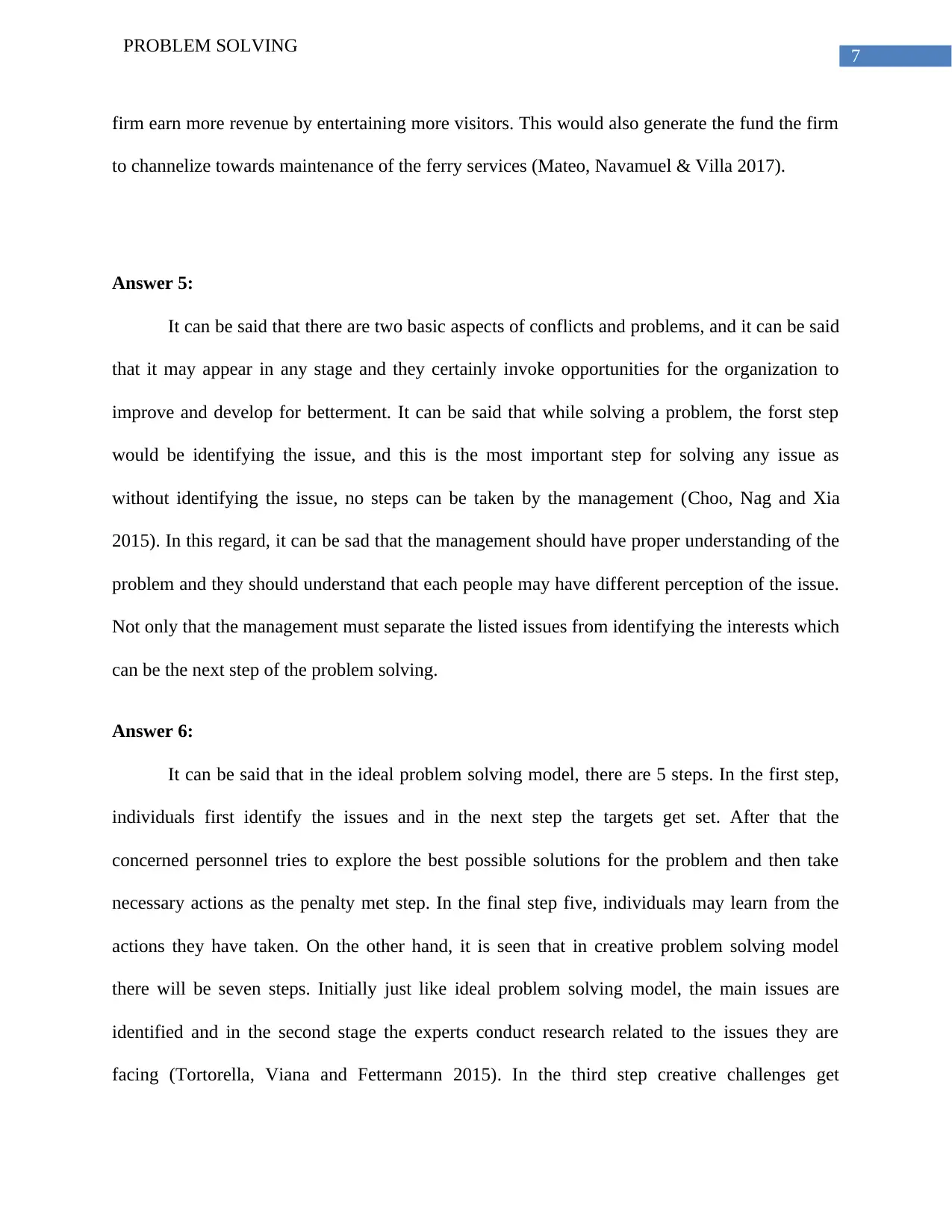
7
PROBLEM SOLVING
firm earn more revenue by entertaining more visitors. This would also generate the fund the firm
to channelize towards maintenance of the ferry services (Mateo, Navamuel & Villa 2017).
Answer 5:
It can be said that there are two basic aspects of conflicts and problems, and it can be said
that it may appear in any stage and they certainly invoke opportunities for the organization to
improve and develop for betterment. It can be said that while solving a problem, the forst step
would be identifying the issue, and this is the most important step for solving any issue as
without identifying the issue, no steps can be taken by the management (Choo, Nag and Xia
2015). In this regard, it can be sad that the management should have proper understanding of the
problem and they should understand that each people may have different perception of the issue.
Not only that the management must separate the listed issues from identifying the interests which
can be the next step of the problem solving.
Answer 6:
It can be said that in the ideal problem solving model, there are 5 steps. In the first step,
individuals first identify the issues and in the next step the targets get set. After that the
concerned personnel tries to explore the best possible solutions for the problem and then take
necessary actions as the penalty met step. In the final step five, individuals may learn from the
actions they have taken. On the other hand, it is seen that in creative problem solving model
there will be seven steps. Initially just like ideal problem solving model, the main issues are
identified and in the second stage the experts conduct research related to the issues they are
facing (Tortorella, Viana and Fettermann 2015). In the third step creative challenges get
PROBLEM SOLVING
firm earn more revenue by entertaining more visitors. This would also generate the fund the firm
to channelize towards maintenance of the ferry services (Mateo, Navamuel & Villa 2017).
Answer 5:
It can be said that there are two basic aspects of conflicts and problems, and it can be said
that it may appear in any stage and they certainly invoke opportunities for the organization to
improve and develop for betterment. It can be said that while solving a problem, the forst step
would be identifying the issue, and this is the most important step for solving any issue as
without identifying the issue, no steps can be taken by the management (Choo, Nag and Xia
2015). In this regard, it can be sad that the management should have proper understanding of the
problem and they should understand that each people may have different perception of the issue.
Not only that the management must separate the listed issues from identifying the interests which
can be the next step of the problem solving.
Answer 6:
It can be said that in the ideal problem solving model, there are 5 steps. In the first step,
individuals first identify the issues and in the next step the targets get set. After that the
concerned personnel tries to explore the best possible solutions for the problem and then take
necessary actions as the penalty met step. In the final step five, individuals may learn from the
actions they have taken. On the other hand, it is seen that in creative problem solving model
there will be seven steps. Initially just like ideal problem solving model, the main issues are
identified and in the second stage the experts conduct research related to the issues they are
facing (Tortorella, Viana and Fettermann 2015). In the third step creative challenges get
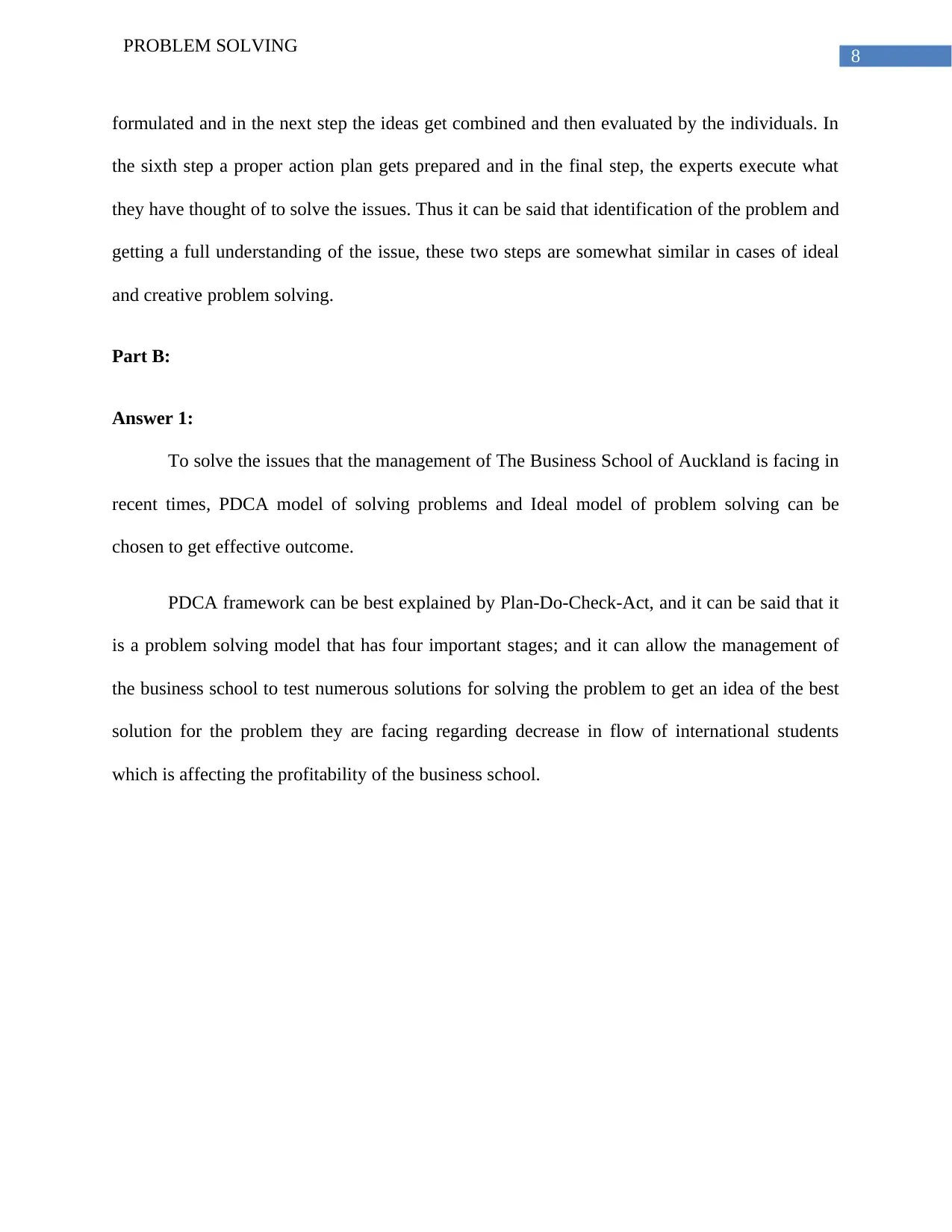
8
PROBLEM SOLVING
formulated and in the next step the ideas get combined and then evaluated by the individuals. In
the sixth step a proper action plan gets prepared and in the final step, the experts execute what
they have thought of to solve the issues. Thus it can be said that identification of the problem and
getting a full understanding of the issue, these two steps are somewhat similar in cases of ideal
and creative problem solving.
Part B:
Answer 1:
To solve the issues that the management of The Business School of Auckland is facing in
recent times, PDCA model of solving problems and Ideal model of problem solving can be
chosen to get effective outcome.
PDCA framework can be best explained by Plan-Do-Check-Act, and it can be said that it
is a problem solving model that has four important stages; and it can allow the management of
the business school to test numerous solutions for solving the problem to get an idea of the best
solution for the problem they are facing regarding decrease in flow of international students
which is affecting the profitability of the business school.
PROBLEM SOLVING
formulated and in the next step the ideas get combined and then evaluated by the individuals. In
the sixth step a proper action plan gets prepared and in the final step, the experts execute what
they have thought of to solve the issues. Thus it can be said that identification of the problem and
getting a full understanding of the issue, these two steps are somewhat similar in cases of ideal
and creative problem solving.
Part B:
Answer 1:
To solve the issues that the management of The Business School of Auckland is facing in
recent times, PDCA model of solving problems and Ideal model of problem solving can be
chosen to get effective outcome.
PDCA framework can be best explained by Plan-Do-Check-Act, and it can be said that it
is a problem solving model that has four important stages; and it can allow the management of
the business school to test numerous solutions for solving the problem to get an idea of the best
solution for the problem they are facing regarding decrease in flow of international students
which is affecting the profitability of the business school.
⊘ This is a preview!⊘
Do you want full access?
Subscribe today to unlock all pages.

Trusted by 1+ million students worldwide
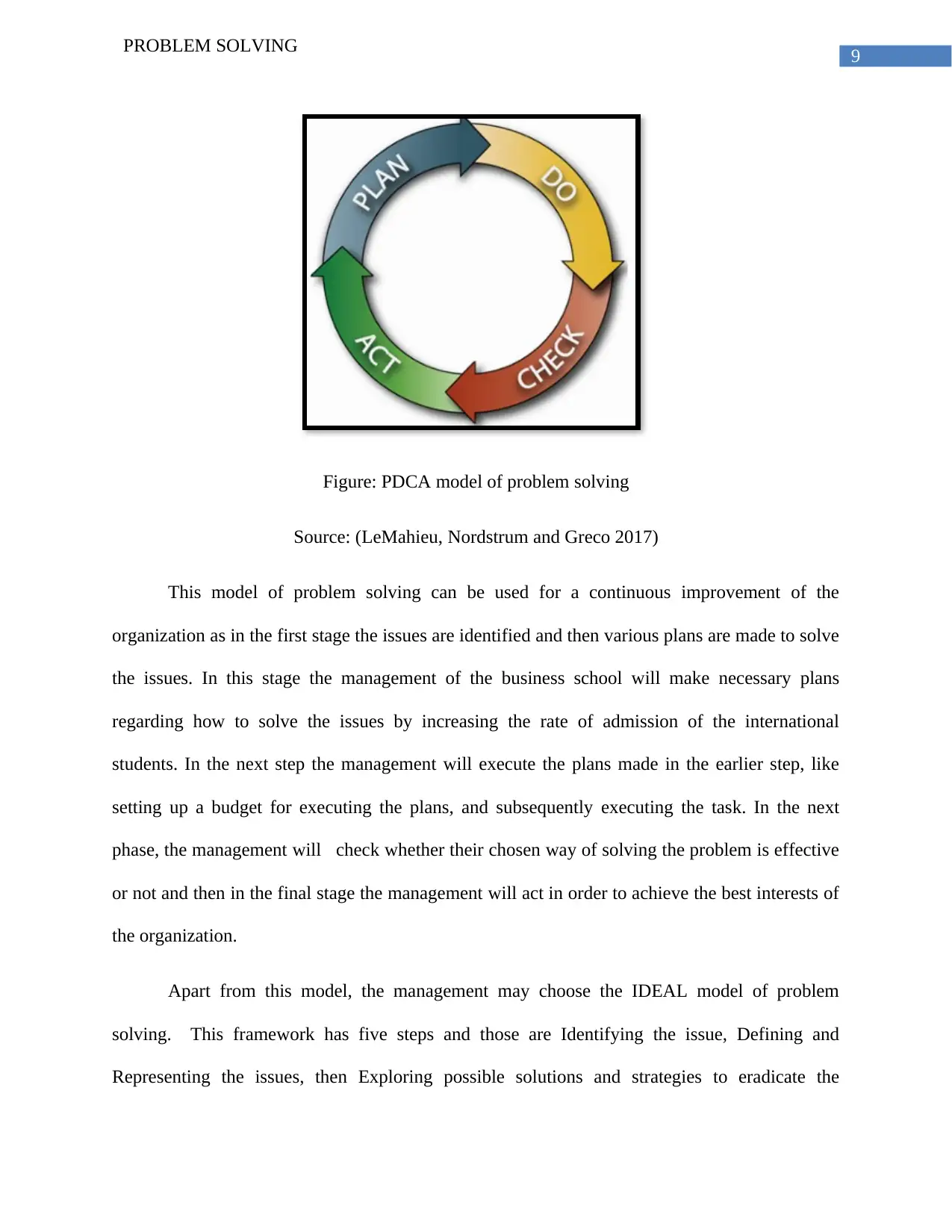
9
PROBLEM SOLVING
Figure: PDCA model of problem solving
Source: (LeMahieu, Nordstrum and Greco 2017)
This model of problem solving can be used for a continuous improvement of the
organization as in the first stage the issues are identified and then various plans are made to solve
the issues. In this stage the management of the business school will make necessary plans
regarding how to solve the issues by increasing the rate of admission of the international
students. In the next step the management will execute the plans made in the earlier step, like
setting up a budget for executing the plans, and subsequently executing the task. In the next
phase, the management will check whether their chosen way of solving the problem is effective
or not and then in the final stage the management will act in order to achieve the best interests of
the organization.
Apart from this model, the management may choose the IDEAL model of problem
solving. This framework has five steps and those are Identifying the issue, Defining and
Representing the issues, then Exploring possible solutions and strategies to eradicate the
PROBLEM SOLVING
Figure: PDCA model of problem solving
Source: (LeMahieu, Nordstrum and Greco 2017)
This model of problem solving can be used for a continuous improvement of the
organization as in the first stage the issues are identified and then various plans are made to solve
the issues. In this stage the management of the business school will make necessary plans
regarding how to solve the issues by increasing the rate of admission of the international
students. In the next step the management will execute the plans made in the earlier step, like
setting up a budget for executing the plans, and subsequently executing the task. In the next
phase, the management will check whether their chosen way of solving the problem is effective
or not and then in the final stage the management will act in order to achieve the best interests of
the organization.
Apart from this model, the management may choose the IDEAL model of problem
solving. This framework has five steps and those are Identifying the issue, Defining and
Representing the issues, then Exploring possible solutions and strategies to eradicate the
Paraphrase This Document
Need a fresh take? Get an instant paraphrase of this document with our AI Paraphraser
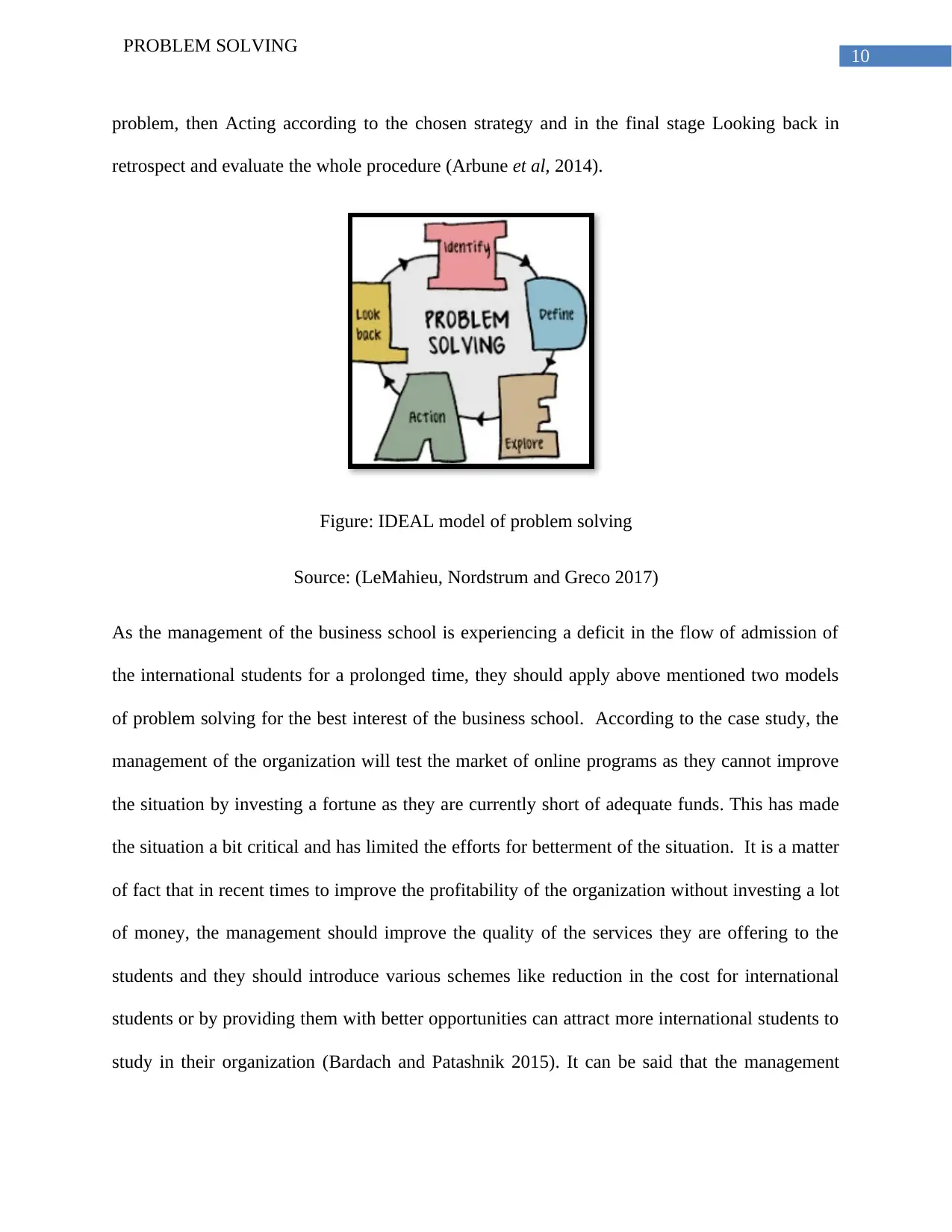
10
PROBLEM SOLVING
problem, then Acting according to the chosen strategy and in the final stage Looking back in
retrospect and evaluate the whole procedure (Arbune et al, 2014).
Figure: IDEAL model of problem solving
Source: (LeMahieu, Nordstrum and Greco 2017)
As the management of the business school is experiencing a deficit in the flow of admission of
the international students for a prolonged time, they should apply above mentioned two models
of problem solving for the best interest of the business school. According to the case study, the
management of the organization will test the market of online programs as they cannot improve
the situation by investing a fortune as they are currently short of adequate funds. This has made
the situation a bit critical and has limited the efforts for betterment of the situation. It is a matter
of fact that in recent times to improve the profitability of the organization without investing a lot
of money, the management should improve the quality of the services they are offering to the
students and they should introduce various schemes like reduction in the cost for international
students or by providing them with better opportunities can attract more international students to
study in their organization (Bardach and Patashnik 2015). It can be said that the management
PROBLEM SOLVING
problem, then Acting according to the chosen strategy and in the final stage Looking back in
retrospect and evaluate the whole procedure (Arbune et al, 2014).
Figure: IDEAL model of problem solving
Source: (LeMahieu, Nordstrum and Greco 2017)
As the management of the business school is experiencing a deficit in the flow of admission of
the international students for a prolonged time, they should apply above mentioned two models
of problem solving for the best interest of the business school. According to the case study, the
management of the organization will test the market of online programs as they cannot improve
the situation by investing a fortune as they are currently short of adequate funds. This has made
the situation a bit critical and has limited the efforts for betterment of the situation. It is a matter
of fact that in recent times to improve the profitability of the organization without investing a lot
of money, the management should improve the quality of the services they are offering to the
students and they should introduce various schemes like reduction in the cost for international
students or by providing them with better opportunities can attract more international students to
study in their organization (Bardach and Patashnik 2015). It can be said that the management
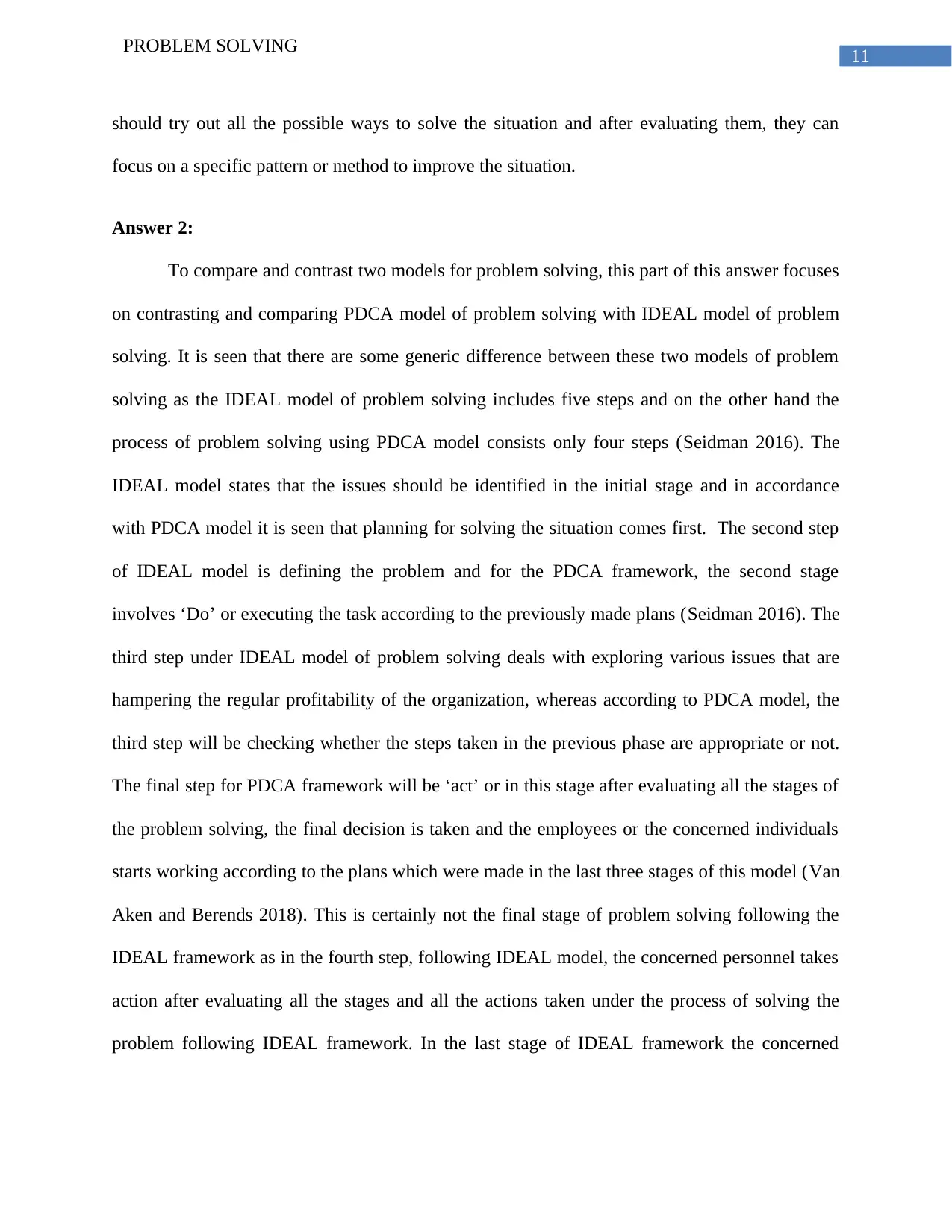
11
PROBLEM SOLVING
should try out all the possible ways to solve the situation and after evaluating them, they can
focus on a specific pattern or method to improve the situation.
Answer 2:
To compare and contrast two models for problem solving, this part of this answer focuses
on contrasting and comparing PDCA model of problem solving with IDEAL model of problem
solving. It is seen that there are some generic difference between these two models of problem
solving as the IDEAL model of problem solving includes five steps and on the other hand the
process of problem solving using PDCA model consists only four steps (Seidman 2016). The
IDEAL model states that the issues should be identified in the initial stage and in accordance
with PDCA model it is seen that planning for solving the situation comes first. The second step
of IDEAL model is defining the problem and for the PDCA framework, the second stage
involves ‘Do’ or executing the task according to the previously made plans (Seidman 2016). The
third step under IDEAL model of problem solving deals with exploring various issues that are
hampering the regular profitability of the organization, whereas according to PDCA model, the
third step will be checking whether the steps taken in the previous phase are appropriate or not.
The final step for PDCA framework will be ‘act’ or in this stage after evaluating all the stages of
the problem solving, the final decision is taken and the employees or the concerned individuals
starts working according to the plans which were made in the last three stages of this model (Van
Aken and Berends 2018). This is certainly not the final stage of problem solving following the
IDEAL framework as in the fourth step, following IDEAL model, the concerned personnel takes
action after evaluating all the stages and all the actions taken under the process of solving the
problem following IDEAL framework. In the last stage of IDEAL framework the concerned
PROBLEM SOLVING
should try out all the possible ways to solve the situation and after evaluating them, they can
focus on a specific pattern or method to improve the situation.
Answer 2:
To compare and contrast two models for problem solving, this part of this answer focuses
on contrasting and comparing PDCA model of problem solving with IDEAL model of problem
solving. It is seen that there are some generic difference between these two models of problem
solving as the IDEAL model of problem solving includes five steps and on the other hand the
process of problem solving using PDCA model consists only four steps (Seidman 2016). The
IDEAL model states that the issues should be identified in the initial stage and in accordance
with PDCA model it is seen that planning for solving the situation comes first. The second step
of IDEAL model is defining the problem and for the PDCA framework, the second stage
involves ‘Do’ or executing the task according to the previously made plans (Seidman 2016). The
third step under IDEAL model of problem solving deals with exploring various issues that are
hampering the regular profitability of the organization, whereas according to PDCA model, the
third step will be checking whether the steps taken in the previous phase are appropriate or not.
The final step for PDCA framework will be ‘act’ or in this stage after evaluating all the stages of
the problem solving, the final decision is taken and the employees or the concerned individuals
starts working according to the plans which were made in the last three stages of this model (Van
Aken and Berends 2018). This is certainly not the final stage of problem solving following the
IDEAL framework as in the fourth step, following IDEAL model, the concerned personnel takes
action after evaluating all the stages and all the actions taken under the process of solving the
problem following IDEAL framework. In the last stage of IDEAL framework the concerned
⊘ This is a preview!⊘
Do you want full access?
Subscribe today to unlock all pages.

Trusted by 1+ million students worldwide
1 out of 16
Your All-in-One AI-Powered Toolkit for Academic Success.
+13062052269
info@desklib.com
Available 24*7 on WhatsApp / Email
![[object Object]](/_next/static/media/star-bottom.7253800d.svg)
Unlock your academic potential
Copyright © 2020–2025 A2Z Services. All Rights Reserved. Developed and managed by ZUCOL.


